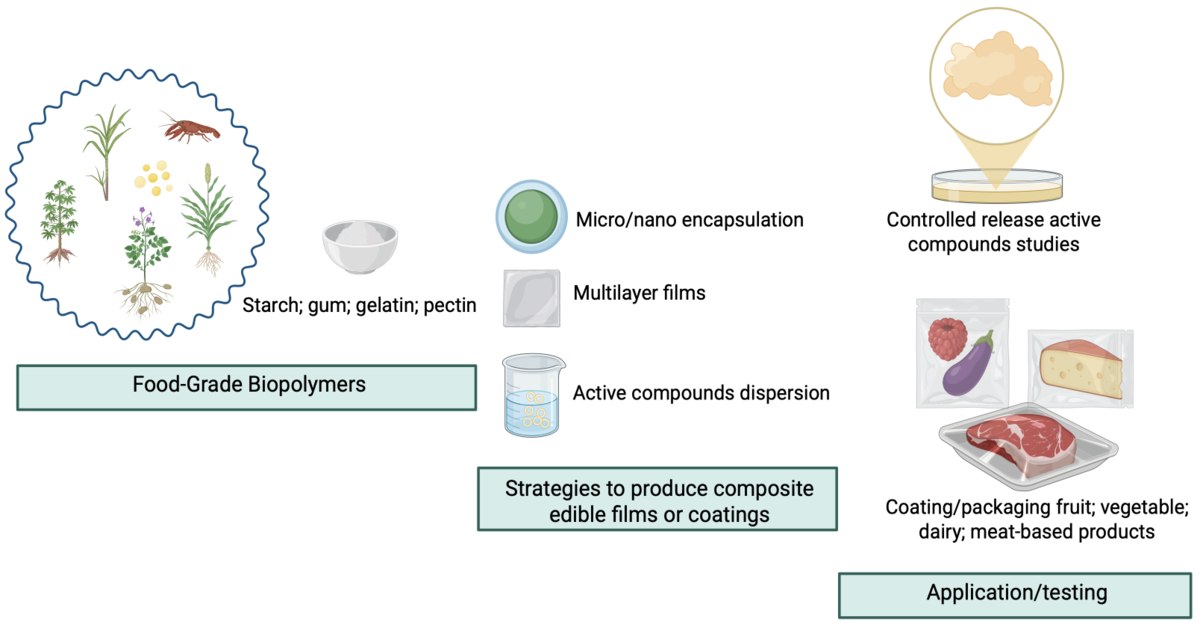- 5.1Impact Factor
- 8.7CiteScore
- 15 daysTime to First Decision
Composite Edible Films and Coatings from Food-Grade Biopolymers
This special issue belongs to the section “Food Packaging and Preservation“.
Special Issue Information
Dear Colleagues,
Packaging can play an important role in increasing shelf life and food safety, as well as reducing food waste. Edible films and coatings can act passively as a physical barrier, restricting water loss and controlling the gases present in the atmosphere, thus modulating the fruit ripening process, for example. They can also function actively by scavenging molecules or releasing compounds with biological activity, reducing microbial growth and the oxidative rancidity of packaged foods. Different active materials, such as plant extracts and essential oils, have been studied as carriers of activity in edible films and coatings. As such, it is necessary to know how the release and action of active molecules occurs. Especially when applied as a coating, the biopolymers and all additives present in the film formulation will be ingested together with the food, so the entire film composition must be safe for ingestion. Thus, many food-grade biopolymers have been studied—such as starch, gelatin and chitosan, among others—for the production of these materials.
We are pleased to invite you to contribute to this Special Issue, which is aimed at bringing the latest innovations in edible films and coatings, focused on their development and/or application in different foods. Reviews and original research articles are welcome. Research areas may include (but are not limited to) the following:
- Development of edible films and coatings based on food-grade polymers;
- Incorporation of bioactive compounds in edible films and coatings for the development of active or intelligent packaging;
- Studies of the bioavailability and release kinetics of the bioactive compounds in films;
- Evaluation of the shelf life of foods with edible films and coatings.
We look forward to receiving your contributions.
Dr. Juliano Zanela
Dr. Gracielle Johann
Dr. Marianne A. Shirai
Guest Editors
Manuscript Submission Information
Manuscripts should be submitted online at www.mdpi.com by registering and logging in to this website. Once you are registered, click here to go to the submission form. Manuscripts can be submitted until the deadline. All submissions that pass pre-check are peer-reviewed. Accepted papers will be published continuously in the journal (as soon as accepted) and will be listed together on the special issue website. Research articles, review articles as well as short communications are invited. For planned papers, a title and short abstract (about 250 words) can be sent to the Editorial Office for assessment.
Submitted manuscripts should not have been published previously, nor be under consideration for publication elsewhere (except conference proceedings papers). All manuscripts are thoroughly refereed through a single-blind peer-review process. A guide for authors and other relevant information for submission of manuscripts is available on the Instructions for Authors page. Foods is an international peer-reviewed open access semimonthly journal published by MDPI.
Please visit the Instructions for Authors page before submitting a manuscript. The Article Processing Charge (APC) for publication in this open access journal is 2900 CHF (Swiss Francs). Submitted papers should be well formatted and use good English. Authors may use MDPI's English editing service prior to publication or during author revisions.
Keywords
- shelf life extension
- active films/ coatings
- smart films/ coatings
- food safety
- food quality
- bioactive compounds
- compounds release kinetics
- by-products

Benefits of Publishing in a Special Issue
- Ease of navigation: Grouping papers by topic helps scholars navigate broad scope journals more efficiently.
- Greater discoverability: Special Issues support the reach and impact of scientific research. Articles in Special Issues are more discoverable and cited more frequently.
- Expansion of research network: Special Issues facilitate connections among authors, fostering scientific collaborations.
- External promotion: Articles in Special Issues are often promoted through the journal's social media, increasing their visibility.
- e-Book format: Special Issues with more than 10 articles can be published as dedicated e-books, ensuring wide and rapid dissemination.

